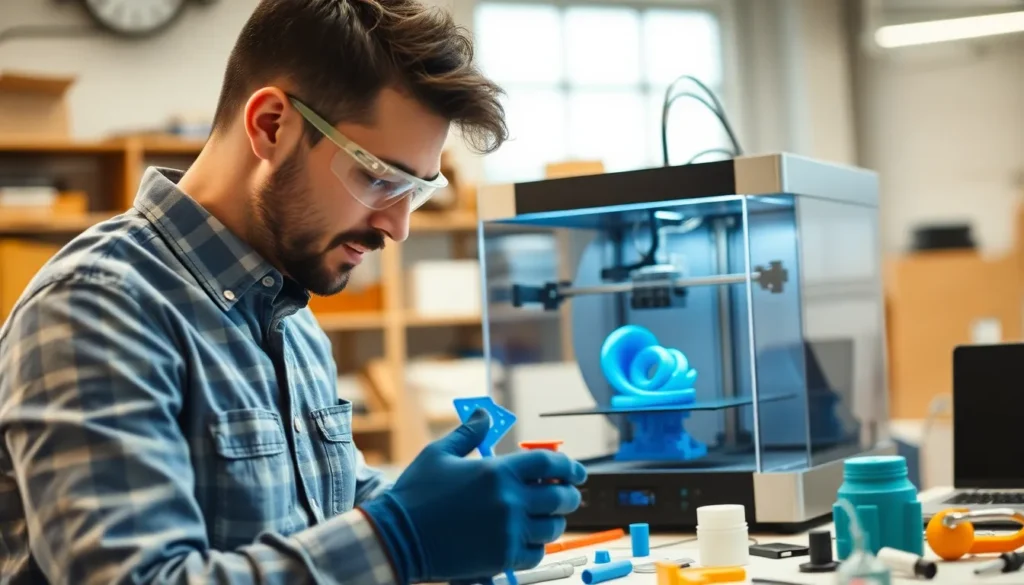Table of Contents
ToggleIn the ever-evolving world of 3D printing, dimensional accuracy is the unsung hero of innovation. Imagine crafting a perfect replica of your favorite coffee mug, only to find it fits your cat instead. Not exactly the result you were after, right? Dimensional accuracy ensures that what you print is what you intended, making it a game-changer for hobbyists and professionals alike.
Understanding 3D Printing Dimensional Accuracy
Dimensional accuracy plays a pivotal role in 3D printing. It directly impacts the quality and functionality of printed objects, affecting both aesthetics and performance.
Definition and Importance
Dimensional accuracy refers to how closely a 3D printed object matches the intended dimensions specified in a digital model. Precision matters significantly in various applications, such as engineering and healthcare. Accurate dimensions ensure parts fit together correctly, which is crucial for assemblies. A 3D printed component that doesn’t meet the specified tolerance can result in costly redesigns and production delays. Ensuring dimensional accuracy enhances the reliability of prototypes and end-use products alike.
Factors Affecting Dimensional Accuracy
Several factors influence dimensional accuracy in 3D printing. Print speed impacts layer adhesion, which may lead to dimensional shifts. Material choice also plays a role; some materials shrink more than others during cooling. Printer calibration is essential; an uncalibrated printer can result in inconsistent results. Environmental conditions such as temperature and humidity can further affect print quality. Operator experience contributes to accuracy as well; skilled operators can better manage the printing process for optimal results.
Techniques for Measuring Dimensional Accuracy
Measuring dimensional accuracy ensures that 3D printed objects meet specified requirements. Various methods and tools exist to assess how closely prints conform to design expectations.
Common Measurement Methods
Calipers serve as one of the most widely used tools in measuring 3D printed objects. Digital calipers provide precise measurements of internal and external dimensions. Another method involves using a coordinate measuring machine (CMM), which captures the physical object’s dimensions via a probe. Additionally, photogrammetry utilizes multiple photographs to calculate dimensions and ensure accuracy. Laser scanning is effective as well, capturing detailed 3D representations of objects for comparison against CAD models.
Tools and Equipment Used
Measurement requires specialized tools to ensure precision. Calipers, both digital and analog, enable quick and accurate readings. Micrometers offer higher precision for finer measurements. CMMs are utilized for large production setups, allowing for automated and repeatable measurements. Photogrammetry software translates images into accurate dimensional data, while laser scanners provide point cloud data for thorough analysis. All these tools contribute to achieving the desired dimensional accuracy in 3D printing projects.
Improving Dimensional Accuracy in 3D Printing
Improving dimensional accuracy in 3D printing involves several key practices. Addressing these areas ensures higher precision in final outputs.
Printer Calibration
Calibrating a 3D printer is crucial for achieving accurate dimensions. Regular adjustments to the bed leveling prevent misalignments during printing. Maintaining the correct nozzle height results in better layer adhesion and consistency. Accurate flow rates significantly influence extrusion dimensions, allowing prints to match design specifications. Regular software updates optimize printer performance, enhancing overall accuracy. Engaging with user forums can provide practical tips on effective calibration techniques.
Material Selection
Choosing the right material impacts dimensional accuracy. Different filaments behave uniquely under various printing conditions. For example, PLA offers lower shrinkage, while ABS may warp without proper temperature control. Selecting materials with consistent diameters further aids in maintaining precision. Testing materials before full-scale production identifies potential issues that affect performance. Understanding the properties of specific materials helps align them with project requirements, ensuring better results.
Design Considerations
Incorporating design considerations makes a significant impact on dimensional accuracy. Using precise digital modeling software allows for detailed adjustments tailored to printer specifications. Designing with tolerances in mind prevents issues during assembly with other parts. Including supports in complex geometries helps maintain structural integrity throughout the print. Utilizing proper scaling techniques ensures models retain accuracy when resized. Engaging in a design review process strengthens overall project effectiveness and print reliability.
Case Studies on 3D Printing Dimensional Accuracy
Several case studies showcase the importance of dimensional accuracy in 3D printing. They highlight how precise measurements lead to successful outcomes in various industries.
Success Stories
One notable success story involves a medical device manufacturer that relied on 3D printing to produce custom prosthetics. This company achieved remarkable accuracy by using advanced calibration techniques and selecting the right materials. The use of polycarbonate filaments ensured strong, reliable components. Accurate dimensions resulted in a perfect fit for patients, enhancing comfort and functionality. Another success came from an engineering firm that developed complex assembly parts for aerospace applications. Employing high-resolution printers, they maintained tolerances within 0.1 mm. These efforts reduced assembly errors significantly, saving both time and costs.
Lessons Learned
Lessons learned from these case studies emphasize the importance of thorough calibration and material selection. Regularly checking printer settings ensures consistent accuracy across various projects. Moreover, preferring specific materials based on each application’s requirements enhances results. For instance, knowing that certain types of nylon resist warping under stress can guide engineers toward better choices. Each experience confirms that attention to detail in design and printing processes is crucial. Adaptability in the printing technique can lead to improved accuracy, ultimately resulting in better-quality products.
Conclusion
Achieving dimensional accuracy in 3D printing is essential for creating reliable and functional objects. The interplay of various factors like printer calibration and material choice significantly affects the final product. By prioritizing these elements and employing effective measurement techniques, users can enhance the quality of their prints.
Industries that rely on precision, such as healthcare and engineering, can particularly benefit from improved dimensional accuracy. As technology evolves and practices become more refined, the potential for achieving exceptional results in 3D printing continues to grow. Embracing these strategies not only leads to better outcomes but also fosters innovation and efficiency across diverse applications.




